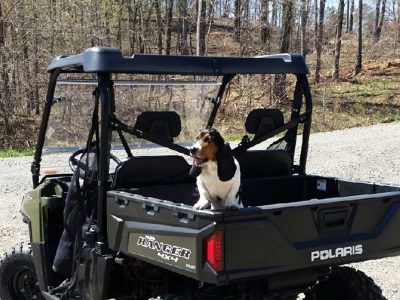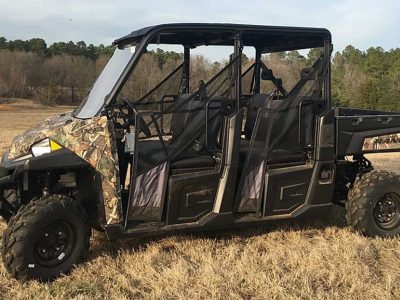ATV Riding
Home » Activities » Outdoor Adventure » ATV Riding
Rev It Up
There are approx. 300 miles of open roads on the Ouachita National Forest (also known as Ouachita Wildlife Management Area) of which only 33 miles are open to ATV riding year round with an additional approx. 20 miles open seasonally (mid May-mid Sept) since the implementation of the Travel Management Plan in May 2011. A deer hunting license is required to ride ATVs and other off-highway vehicles in the Honobia Creek Wildlife Management Area and is only available during deer hunting season. Same rules apply to Three Rivers WMA.
For more detailed information on the rules, restrictions, permit requirements, safety regulations and vehicle laws, please visit our ATV Facts Information page.
For Forest Service regulations and maps, visit www.fs.usda.gov/activity/ouachita/recreation.ohv.
Why can’t I ride my OHV on the Three Rivers WMA?
The increase in OHV use on the Three Rivers WMA over the last 10 years has led to much discussion about the safety risks of all people who use and work on the WMA. The increase in OHV use has also led to an increase in OHV related injuries. While other factors played a role, including environmental issues, safety is the main reason for the OHV rule changes on the Three Rivers WMA.
What types of recreation are available on the Three Rivers WMA since I can no longer ride my ATV?
The 250,000-acre Three Rivers WMA offers some of the best sports recreation opportunities in Oklahoma, including hunting for white-tailed deer, eastern wild turkey, bobwhite quail, fox and gray squirrel, and swamp and cottontail rabbit. The Glover River runs through the heart of the WMA and offers angling opportunities for smallmouth bass, spotted bass, channel catfish, and sunfish. Camping, sightseeing, photography, and bird watching are also popular activities. Visit www.wildlifedepartment.com to view hunting season dates and license fees.
May I ride my OHV off the maintained roads during the deer seasons on the Three Rivers WMA?
No. All OHVs must remain on open established maintained roads that are open for regular vehicle use. The only exception to this is for deer hunters retrieving tagged deer according to specific conditions. Consult the Oklahoma Hunting Guide for specific rules and regulations.
May I still ride my OHV on the county roads within the Three Rivers WMA?
No. Some county roads may exist that go through the WMA, but it is currently illegal to ride an ATV/ORV on a county road even if the road is a gravel road. All vehicles that are legal to be used on Oklahoma State highways are legal to be used on the Three Rivers WMA year-round.
The Ouachita National Forest (Ouachita WMA) is the only area available in the county for legal public use of off-highway vehicles. A deer hunting license is required for the Honobia Creek Wildlife Management area and Three Rivers Wildlife Management area, and is only open to ATV riding to facilitate hunting activities during deer hunting season.
Listed below are rules and regulations for off-highway vehicle (OHV) use in the Ouachita National Forest (Ouachita WMA), Honobia Creek and Three Rivers Wildlife Management Areas. OHVs include ATVs, 4-wheelers, 3-wheelers, utility vehicles such as Mules, and motorcycles. For a more pleasant visit, please take a moment to call the local Forest Service office at 580-494-6402, visit www.fs.usda.gov/activity/ouachita/recreation.ohv, and review the following:
All USFS land/roads south of U.S. 70 are closed to ATV riding especially on the forest floor. Rules on USFS lands in Leflore County are the same as the McCurtain County unit with the exception of designated ATV roads in Leflore county.
- The speed limit on the Ouachita WMA as well as all other WMAs is 25 MPH for all vehicles including street legal and ATVs.
- All ATVs including motorcycles, UTVs etc. are required to have a USFS-approved spark arrestor in working order. Loud modified exhausts are prohibited as well and could be in violation of ODWC rules for Department Managed Lands (WMAs)
- The use or possession of alcoholic beverages or low-point beer is prohibited by forest order on the Ouachita National Forest
- OHVs may ONLY be used National Forest roads designated as open for ATV use by the current Motor Vehicle Use Map (MVUM) available from the US Forest Service. A road is considered closed if it is not listed as being “OPEN” on the current MVUM. Prior illegal OHV use does not imply permission to ride off the open road. Even if someone else went around or over that dirt mound that is closing the road, it doesn’t mean you should do the same. You could receive a fine.
- There are places where trails have been illegally used across the forest floor – be aware these are not open roads and are not legal to use for riding. There are approximately 300 miles of open roads on the forest of which only approximately 33 miles are open to ATVs. There are a few more miles of roads open seasonally to ATVs as designated on the current MVUM. There are many roads on the forest that look like maintained open roads that are still closed to vehicle travel. These are generally roads that have been maintained to USFS specifications for future logging operations. Make sure it is an open-for-OHV-use road before using it. If you aren’t sure then call the Forest Service at 580-494-6402.
- In McCurtain County, OHV use is not permitted on the forest floor (off-road). This includes both north of McCurtain County and south of Hwy 70. There is zero use allowed on the forest floor since there are no open travel routes the forest. The regulations are subject to change, so please call the Forest Service at 580-494-6402 if you are unsure whether OHV use is permitted in a given area.
- A state law is in effect on public lands that requires anyone under the age of 18 to wear a helmet while riding an OHV, and prohibits passengers on OHVs that were not made to carry passengers (after-market modifications do not count).
- OHVs are not allowed on trails designated solely for other uses, including hiking, mountain biking, and equestrian use. Currently there are no designated OHV trails on the forest floor in Oklahoma except for the Indian Nations Trail in LeFlore County, where only motorcycles are allowed.
- Driving on powerlines, pipelines, seismic lines, fire lines, or railroad right-of-ways is prohibited.
- Driving on, or crossing, a paved road is prohibited.
- Driving in streambeds, creek beds, lake beds, or shorelines is prohibited.
- Make sure your vehicle is in good condition with an approved spark arrester.
- Use the appropriate safety gear – helmet (required if under 18), eye protection, boots, and gloves.
- Obey speed limits and be considerate of other visitors. When encountering horse riders, stop and yield the right-of-way since horses may be spooked by motorized vehicles.
The reason for the rules:
Heavy or irresponsible OHV use can wreak havoc on the environment. Miles of unplanned trails from heavy OHV use on the forest floor can damage watersheds, destroy habitats, kill native plant and animal species, and pollute streams and rivers.
To help preserve these resources and the continued opportunities for you to enjoy using your vehicle on public lands, we ask that you observe the guidelines listed above and report violations.
Riding in closed areas can result in a fine and/or imprisonment.
For more information, please call the Forest Service at 580-494-6402.
Effective August 1, 2008, all OHV riding on the Three Rivers Wildlife Management Area and Honobia Creek WMA is prohibited except by licensed deer hunters during the period of Oct. 1 – Jan. 15. All OHV riders must wear a fluorescent orange chest and head covering while operating an OHV. If a crash helmet is worn, then only a fluorescent orange chest covering is required. Consult the Oklahoma Hunting Guide for additional restrictions.
A. It shall be unlawful for a person less than eighteen (18) years of age to operate or to be carried as a passenger upon an all-terrain vehicle unless the person wears a crash helmet of a type which complies with standards established by 49 C.F.R., Section 571.218.
B. It shall be unlawful for the operator of an all-terrain vehicle to carry a passenger unless that all-terrain vehicle has been specifically designed by the manufacturer to carry passengers in addition to the operator.
C. Fine and court costs for violating the provisions of this section shall not exceed Twenty-five Dollars ($25.00). Any peace officer of this state including, but not limited to, park rangers, is authorized to enforce the provisions of this section. All monies collected pursuant to a citation for a violation of this section shall be deposited in the Oklahoma Tourism and Recreation Department Revolving Fund for credit to the cost center of the state park or public recreation area where such citation was issued.
D. Any parent, legal guardian or person having actual responsibility for a person under eighteen (18) years of age, or who is the owner of the all-terrain vehicle operated by a person under eighteen (18) years of age, who knows, or should have known, that the person operating the all-terrain vehicle is not in compliance with the provisions of this section, shall be punishable according to the provisions of subsection C of this section.
E. As used in this section, “all-terrain vehicle” means a motorized vehicle manufactured and used exclusively for off-highway use which is forty-eight (48) inches or less in width, with an unladen dry weight of eight hundred (800) pounds or less, traveling on two or more low-pressure tires, having a seat designed to be straddled by the operator, and which is steered by the use of handlebars.
F. The provisions of this section shall apply only to persons operating all-terrain vehicles on public lands.
G. The provisions of this section shall not apply to persons operating an all-terrain vehicle on privately owned property.


